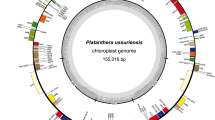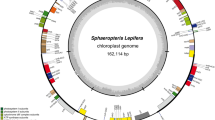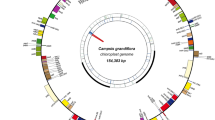Abstract
The complete chloroplast genome (plastome) of the annual flowering halophyte herb Suaeda monoica Forssk. ex J. F. Gmel. family (Amaranthaceae) that grows in Jeddah, Saudi Arabia, was identified for the first time in this study. Suaeda monoica is a medicinal plant species whose taxonomic classification remains controversial. Further, studying the species is useful for current conservation and management efforts. In the current study, the full chloroplast genome S. monoica was reassembled using whole-genome next-generation sequencing and compared with the previously published chloroplast genomes of Suaeda species. The chloroplast genome size of Suaeda monoica was 151,789 bp, with a single large copy of 83,404 bp, a small single copy of 18,007 bp and two inverted repeats regions of 25,189 bp. GC content in the whole genome was 36.4%. The cp genome included 87 genes that coded for proteins, 37 genes coding for tRNA, 8 genes coding for rRNA and one non-coding pseudogene. Five chloroplast genome features were compared between S. monoica and S. japonica, S. glauca, S. salsa, S. malacosperma and S. physophora. Among Suaeda genus and equal to most angiosperms chloroplast genomes, the RSCU values were conservative. Two pseudogenes (accD and ycf1), rpl16 intron and ndhF-rpl32 intergenic spacer, were highlighted as suitable DNA barcodes for different Suaeda species. Phylogenetic analyses show Suaeda cluster into three main groups; one in which S. monoica was closer to S. salsa. The obtained result provided valuable information on the characteristics of the S. monoica chloroplast genome and the phylogenetic relationships.








Similar content being viewed by others
Data availability
The complete sequence of S. monoica is deposited into NCBI GenBank accession number OP002735.
References
Chung Y (1992) A taxonomic study of the Korean Chenopodiaceae. Sungkyunkwan University, Seoul
El-Demerdash MA, Hegazy AK, Zilay AM (1994) Distribution of the plant communities in Tihamah coastal plains of Jazan region, Saudi Arabia. Vegetatio 112:141–151. https://doi.org/10.1007/BF00044688
Kim Y, Park J, Chung Y (2019) The complete chloroplast genome of Suaeda japonica Makino (Amaranthaceae). Mitochondrial DNA Part B 4:1505–1507. https://doi.org/10.1080/23802359.2019.1601039
Devadatha B (2018) Deniquelata vittalii sp. nov., a novel Indian saprobic marine fungus on Suaeda monoica and two new records of marine fungi from Muthupet mangroves, East coast of India. Mycosphere 9:565–582. https://doi.org/10.5943/mycosphere/9/3/8
Ayyappan D, Balakrishnan V, Ravindran K (2013) Potentiality of Suaeda monoica Forsk a salt marsh halophyte on restoration of saline agricultural soil. World Appl Sci J 28:2026–2032
Bandaranayake WM (1998) Traditional and medicinal uses of mangroves. Mangrove Salt Marshes 2:133–148. https://doi.org/10.1023/A:1009988607044
Arockiya Aarthi Rajathi F, Arumugam R, Saravanan S, Anantharaman P (2014) Phytofabrication of gold nanoparticles assisted by leaves of Suaeda monoica and its free radical scavenging property. J Photochem Photobiol, B 135:75–80. https://doi.org/10.1016/j.jphotobiol.2014.03.016
Joshi A, Kanthaliya B, Rajput V et al (2020) Assessment of phytoremediation capacity of three halophytes: Suaeda monoica, Tamarix indica and Cressa critica. Biol Futur 71:301–312. https://doi.org/10.1007/s42977-020-00038-0
Muthazhagan K, Thirunavukkarasu P, Ramanathan T, Kannan D (2014) Studies on phytochemical screening, antimicrobial and anti radical scavenging effect coastal salt mash plant of a Suaeda monoica. Res J phytochem 8(3):102–111
Al-Said MS, Siddiqui NA, Mukhair MA et al (2017) A novel monocyclic triterpenoid and a norsesquaterpenol from the aerial parts of Suaeda monoica Forssk. ex J.F. Gmel with cell proliferative potential. Saudi Pharm J 25:1005–1010. https://doi.org/10.1016/j.jsps.2017.03.008
Safhi FA, Alshamrani SM, Jalal AS, Abd El-Moneim D, Alyamani AA, Ibrahim AA (2022) Genetic characterization of some Saudi Arabia’s accessions from Commiphora gileadensis using physio-biochemical parameters, molecular markers, DNA barcoding analysis and relative gene expression. Genes 13:2099. https://doi.org/10.3390/genes13112099
Abd El Moneim DA, Mohamed IN, Belal AH, Atta ME (2010) Screen in g bread wheat genotypes for drought tolerance: Germination, radical growth and mean performance of yield and its components. In: López-Francos A (ed) Economics of drought and drought preparedness in a climate change context. CIHEAM/FAO/ICARDA/GDAR/CEIGRAM/MARM, Zaragoza, pp 301–305
Bausher MG, Singh ND, Lee SB et al (2006) The complete chloroplast genome sequence of Citrus sinensis (L) Osbeck var “Ridge Pineapple”: organization and phylogenetic relationships to other angiosperms. BMC Plant Biol 6:21. https://doi.org/10.1186/1471-2229-6-21
Odintsova MS, Yurina NP (2006) Chloroplast genomics of land plants and algae. Biotechnological applications of photosynthetic proteins: biochips, biosensors and biodevices. Springer, pp 57–72
Ruhlman TA, Jansen RK (2014) The plastid genomes of flowering plants. In: Maliga P (ed) Chloroplast biotechnology. Humana Press, Totowa, pp 3–38
Meng XX, Xian YF, Xiang L et al (2018) Complete chloroplast genomes from Sanguisorba: identity and variation among four species. Molecules 23:2137. https://doi.org/10.3390/molecules23092137
Sun JL, Han Y, Cui XM, Liu Y (2020) Development and application of chloroplast molecular markers in Panax notoginseng. China J Chin Mater Med 45:1342–1349
Dong S, Zhang S, Zhang L et al (2021) Plastid genomes and phylogenomics of liverworts (Marchantiophyta): conserved genome structure but highest relative plastid substitution rate in land plants. Mol Phylogenet Evol 161:107171
Guo XL, Zheng HY, Price M et al (2020) Phylogeny and comparative analysis of Chinese Chamaesium species revealed by the complete plastid genome. Plants 9:965. https://doi.org/10.3390/plants9080965
Qu XJ, Li XT, Zhang LY et al (2019) Characterization of the complete chloroplast genome of Suaeda salsa (Amaranthaceae/Chenopodiaceae), an annual succulent halophyte. Mitochondrial DNA Part B 4:2133–2134. https://doi.org/10.1080/23802359.2019.1623113
Qu XJ, Liu LK, Zhang LY et al (2019) The complete chloroplast genome of an annual halophyte herb, Suaeda glauca (Amaranthaceae). Mitochondrial DNA Part B 4:2780–2781. https://doi.org/10.1080/23802359.2019.1659111
Park JS, Choi IS, Lee DH, Choi BH (2018) The complete plastid genome of Suaeda malacosperma (Amaranthaceae/Chenopodiaceae), a vulnerable halophyte in coastal regions of Korea and Japan. Mitochondrial DNA Part B 3:382–383. https://doi.org/10.1080/23802359.2018.1437822
Hu Y, Ren X, Zhang J (2022) The complete chloroplast genome of Suaeda physophora Pall. (Chenopodiaceae). Mitochondrial DNA Part B 7:1594–1596. https://doi.org/10.1080/23802359.2022.2115322
Magdy M, Ou L, Yu H et al (2019) Pan-plastome approach empowers the assessment of genetic variation in cultivated Capsicum species. Hortic Res 6:108. https://doi.org/10.1038/s41438-019-0191-x
Magdy M, Ouyang B (2020) The complete mitochondrial genome of the chiltepin pepper (Capsicum annuum var. glabriusculum), the wild progenitor of Capsicum annuum L. Mitochondrial DNA Part B 5:683–684. https://doi.org/10.1080/23802359.2020.1714496
Magdy M, El-Sherbeny EA, Ramirez Sanchez A (2022) The complete chloroplast genome of the Egyptian henbane (Hyoscyamus muticus L., Solanaceae). Mitochondrial DNA Part B 7:1109–1111
Kearse M, Moir R, Wilson A et al (2012) Geneious Basic: an integrated and extendable desktop software platform for the organization and analysis of sequence data. Bioinformatics 28:1647–1649. https://doi.org/10.1093/bioinformatics/bts199
Tillich M, Lehwark P, Pellizzer T et al (2017) GeSeq—versatile and accurate annotation of organelle genomes. Nucleic Acids Res 45:W6–W11. https://doi.org/10.1093/nar/gkx391
Lowe TM, Chan PP (2016) tRNAscan-SE on-line: integrating search and context for analysis of transfer RNA genes. Nucleic Acids Res 44:W54–W57. https://doi.org/10.1093/nar/gkw413
Beier S, Thiel T, Münch T et al (2017) MISA-web: a web server for microsatellite prediction. Bioinformatics 33:2583–2585. https://doi.org/10.1093/bioinformatics/btx198
Kumar S, Stecher G, Li M et al (2018) MEGA X: molecular evolutionary genetics analysis across computing platforms. Mol Biol Evol 35:1547–1549. https://doi.org/10.1093/molbev/msy096
Darling ACE, Mau B, Blattner FR, Perna NT (2004) Mauve: multiple alignment of conserved genomic sequence with rearrangements. Genome Res 14:1394. https://doi.org/10.1101/gr.2289704
Price MN, Dehal PS, Arkin AP (2010) FastTree 2—approximately maximum-likelihood trees for large alignments. PLoS ONE 5:e9490. https://doi.org/10.1371/journal.pone.0009490
Daniell H, Lin CS, Yu M, Chang WJ (2016) Chloroplast genomes: diversity, evolution and applications in genetic engineering. Genome Biol 17:1–29
Li B, Li Y, Cai Q et al (2016) Development of chloroplast genomic resources for Akebia quinata (Lardizabalaceae). Conserv Genet Resour 8:447–449
Li Z, Long H, Zhang L et al (2017) The complete chloroplast genome sequence of tung tree (Vernicia fordii): organization and phylogenetic relationships with other angiosperms. Sci Rep 7:1869. https://doi.org/10.1038/s41598-017-02076-6
Guan Y, Liu W, Duan B et al (2022) The first complete chloroplast genome of Vicatia thibetica de Boiss.: genome features, comparative analysis and phylogenetic relationships. Physiol Mol Biol Plants 28:439–454. https://doi.org/10.1007/s12298-022-01154-y
Chincoya DA, Sanchez-Flores A, Estrada K et al (2020) Identification of high molecular variation loci in complete chloroplast genomes of Mammillaria (Cactaceae, Caryophyllales). Genes 11:830. https://doi.org/10.3390/genes11070830
ElShamey EA, Sakran RM, ElSayed MA, Aloufi S, Alharthi B, Alqurashi M, Mansour E, Abd El-Moneim D (2022) Heterosis and combining ability for floral and yield characters in rice using cytoplasmic male sterility system. Saudi J Biol Sci 29:3727–3738
Shen Z, Gan Z, Zhang F et al (2020) Analysis of codon usage patterns in citrus based on coding sequence data. BMC Genomics 21:234. https://doi.org/10.1186/s12864-020-6641-x
Omar M, Rabie HA, Mowafi SA, Othman HT, El-Moneim DA, Alharbi K, Mansour E, Ali MMA (2022) Multivariate analysis of agronomic traits in newly developed maize hybrids grown under different agro-environments. Plants 11:1187. https://doi.org/10.3390/plants11091187
Hanson G, Coller J (2018) Codon optimality, bias and usage in translation and mRNA decay. Nat Rev Mol Cell Biol 19:20–30
Wang Z, Cai Q, Wang Y et al (2022) Comparative analysis of codon bias in the chloroplast genomes of Theaceae species. Front Genet 13:824610. https://doi.org/10.3389/fgene.2022.824610
Zhang T, Xing Y, Xu L et al (2019) Comparative analysis of the complete chloroplast genome sequences of six species of Pulsatilla Miller, Ranunculaceae. Chin Med 14:53. https://doi.org/10.1186/s13020-019-0274-5
Kim KJ (2004) Complete chloroplast genome sequences from Korean Ginseng (Panax schinseng Nees) and comparative analysis of sequence evolution among 17 vascular plants. DNA Res 11:247–261. https://doi.org/10.1093/dnares/11.4.247
Li Q, Xia M, Yu J et al (2022) Plastid genome insight to the taxonomic problem for Aconitum pendulum and A. flavum (Ranunculaceae). Biologia 77:953–966. https://doi.org/10.1007/s11756-021-00969-6
Shen X, Guo S, Yin Y et al (2018) Complete chloroplast genome sequence and phylogenetic analysis of Aster tataricus. Molecules 23:2426. https://doi.org/10.3390/molecules23102426
Krawczyk K, Wiland-Szymańska J, Buczkowska-Chmielewska K et al (2018) The complete chloroplast genome of a rare orchid species Liparis loeselii (L.). Conserv Genet Resour 10:305–308. https://doi.org/10.1007/s12686-017-0809-y
Li X, Yang JB, Wang H et al (2021) Plastid NDH pseudogenization and gene loss in a recently derived lineage from the largest hemiparasitic plant genus Pedicularis (Orobanchaceae). Plant Cell Physiol 62:971–984. https://doi.org/10.1093/pcp/pcab074
Lu T, Ke M, Lavoie M et al (2018) Rhizosphere microorganisms can influence the timing of plant flowering. Microbiome 6:231. https://doi.org/10.1186/s40168-018-0615-0
Safhi FA, Alshamrani SM, Fiteha YG, Abd El-Moneim D (1931) DNA barcoding of endangered and rarely occurring plants in Faifa mountains (Jazan, Saudi Arabia). Agriculture 2022:12. https://doi.org/10.3390/agriculture12111931
Safhi FA, Alshamrani SM, Bogmaza AFM, El-Moneim DA (2023) DNA barcoding of wild plants with potential medicinal properties from Faifa mountains in Saudi Arabia. Genes 14:469. https://doi.org/10.3390/genes14020469
Safhi FA, Alshamrani SM, Alshaya DS, Hussein MAA, Abd El-Moneim D (2023) Genetic diversity analysis of banana cultivars (Musa sp.) in Saudi Arabia based on AFLP marker. Curr Issues Mol Biol 45:1810–1819. https://doi.org/10.3390/cimb45030116
Mittler R (2002) Oxidative stress, antioxidants and stress tolerance. Trends Plant Sci 7:405–410
Brossa R, López-Carbonell M, Jubany-Marí T, Alegre L (2011) Interplay between abscisic acid and Jasmonic acid and its role in water-oxidative stress in wild-type, ABA-deficient, JA-deficient and Ascorbate-deficient Arabidopsis plants. J Plant Growth Regul 30:322–333
Kronzucker HJ, Britto DT (2011) Sodium transport in plants: a critical review. New Phytol 189:54–81
Ibrahim AA, Alwutayd KM, Safhi FA et al (2023) Characterization and comparative genomic analyses of complete chloroplast genome on Trema orientalis L. Genet Resour Crop Evol. https://doi.org/10.1007/s10722-023-01678-6
Alshegaihi RM, Mansour H, Alrobaish SA, Al Shaye NA, Abd El-Moneim D (2023) The first complete chloroplast genome of Cordia monoica: structure and comparative analysis. Genes 14:976. https://doi.org/10.3390/genes14050976
Acknowledgements
The author would like to express their deepest gratitude to university of Jeddah, for the technical support for this study.
Funding
This work was funded by the University of Jeddah, Jeddah, Saudi Arabia, under grant No. (UJ-23-FR-89). Therefore, the author thanks the University of Jeddah for its technical and financial support.
Author information
Authors and Affiliations
Corresponding author
Ethics declarations
Conflicts of interest
The author declare no conflict of interest.
Additional information
Publisher's Note
Springer Nature remains neutral with regard to jurisdictional claims in published maps and institutional affiliations.
Rights and permissions
Springer Nature or its licensor (e.g. a society or other partner) holds exclusive rights to this article under a publishing agreement with the author(s) or other rightsholder(s); author self-archiving of the accepted manuscript version of this article is solely governed by the terms of such publishing agreement and applicable law.
About this article
Cite this article
Alshegaihi, R.M. The complete chloroplast genome of the halophyte flowering plant Suaeda monoica from Jeddah, Saudi Arabia. Mol Biol Rep 51, 60 (2024). https://doi.org/10.1007/s11033-023-09069-x
Received:
Accepted:
Published:
DOI: https://doi.org/10.1007/s11033-023-09069-x




